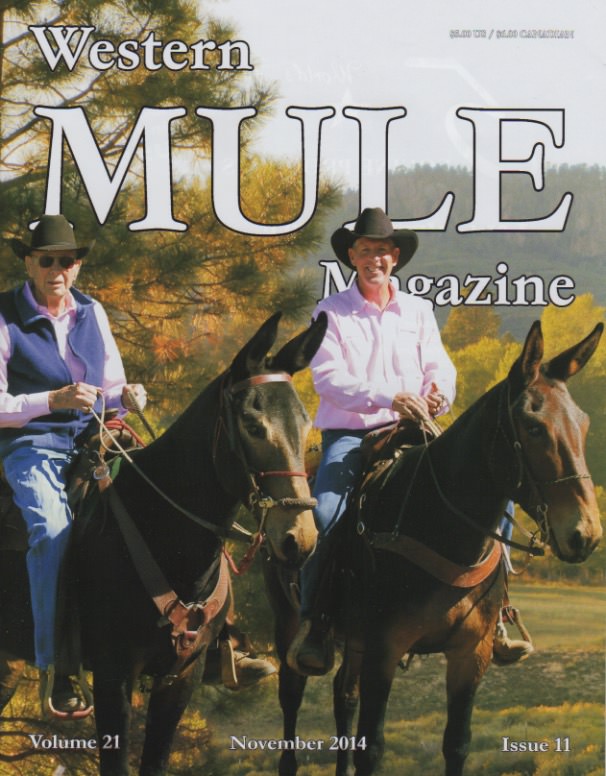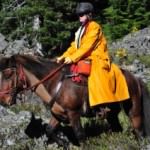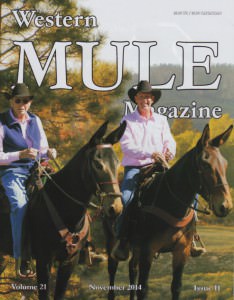 What Do You Rely on When the Day Goes Downhill?
What Do You Rely on When the Day Goes Downhill?
As published by Western Mule Magazine Nov, 2104
My failure to look at a calendar recently resulted in the good fortune of meeting a fellow Western Mule reader, Mr. John H. of the Spokane, Washington area. John is the President of the North Idaho Saddle Mule Club, an all around good guy and a real backcountry resource who teaches the art of survival to military personnel. He’s the real deal.
I had pulled into the location where my Backcountry Horsemen Chapter holds its monthly meetings. That I didn’t recognize many of the faces that were milling about didn’t phase me since I’m not a regular at our gatherings; after all I’d rather be riding. Well I must have looked out of place and John greeted me with “Are you here for the Mule Club?” Well, Mrs. Eversole raised me to always look for the positive and the Mule Club was having a potluck so I stayed!
A few days later John and I ran into each other again and like riders around the world we started talking about some of our various trips. The conversation soon veered towards tales of trail accidents, what riders can do to prepare for these “just in case” situations, and the sad fact that most riders don’t prepare at all.
Even an easy front country “just a day ride” can very quickly turn into a nightmare should the unthinkable happen. If you’re injured and come off your mount how you’ve prepared for the unexpected can well make the difference between an inconvenience and far worse.
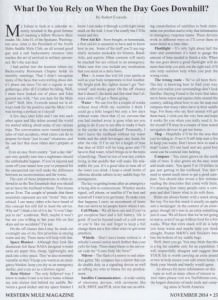 The core of these preparations is often referred to as the Ten Essentials that you should never leave the trailhead without. That means never. Ever. The couple of pounds that these essentials represent are not “extra” they are critical. I see many riders who have heard of this concept but still fail to head the advice. Why not? I think a lot of it is the “it won’t happen to me” syndrome. Well, maybe it won’t but are you willing to bet your life on fair skies and no accidents? I’m not.
The core of these preparations is often referred to as the Ten Essentials that you should never leave the trailhead without. That means never. Ever. The couple of pounds that these essentials represent are not “extra” they are critical. I see many riders who have heard of this concept but still fail to head the advice. Why not? I think a lot of it is the “it won’t happen to me” syndrome. Well, maybe it won’t but are you willing to bet your life on fair skies and no accidents? I’m not.
On the off chance that I may be stuck out overnight one of my first priorities is staying warm and dry. These items will help with that.
 Space Blanket – Although they look like aluminum foil these NASA designed wonder tools are paper thin, cheap, lightweight, and pack into a tiny space. They’re also extremely versatile as they’ll keep you warm as an emergency blanket, keep you dry as an emergency shelter, and even act as a distress signal.
Space Blanket – Although they look like aluminum foil these NASA designed wonder tools are paper thin, cheap, lightweight, and pack into a tiny space. They’re also extremely versatile as they’ll keep you warm as an emergency blanket, keep you dry as an emergency shelter, and even act as a distress signal.
Rain Slicker – The only full proof way I know to make it rain is to leave home without my rain slicker tied behind my saddle. Between a good slicker and my space blanket I know I can make it through a cold night alone stuck on the trail. I won’t be comfy but I’ll be warm and dry.
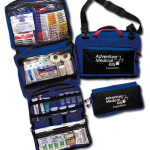 First Aid Kit – Store bought, or home made, a first aid kit is essential to have and to know how to use. Some of the stuff you’ll use regularly include moleskin for blisters, Band-Aids, and aspirin. Other contents will rarely be touched but are critical in an emergency. Make sure that you include any medication that you need on a daily basis. See what I carry in mine,
First Aid Kit – Store bought, or home made, a first aid kit is essential to have and to know how to use. Some of the stuff you’ll use regularly include moleskin for blisters, Band-Aids, and aspirin. Other contents will rarely be touched but are critical in an emergency. Make sure that you include any medication that you need on a daily basis. See what I carry in mine,
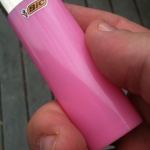 Fire – A warm fire will lift your spirits as well as your body temperature in foul weather. My bright pink Bic lighter doesn’t get “borrowed” and works great. On the off chance that it doesn’t, the knife and fire-steel that I always carry will get a flame going.
Fire – A warm fire will lift your spirits as well as your body temperature in foul weather. My bright pink Bic lighter doesn’t get “borrowed” and works great. On the off chance that it doesn’t, the knife and fire-steel that I always carry will get a flame going.
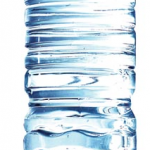 Water – We can live for a couple of weeks without food (With my waistline I think I could go a little longer) but only a few days without water. Once that 12 oz. cerveza that you had stashed away is gone what are you going to do if you’re not able to make it back to the cooler at the trailhead? Personally, I don’t leave the trailhead without my water bottle and the adult beverages stay home for after the ride. If I’m out for a length of time that liter of H2O will be long gone and I’ll have to find water, which brings us to the topic of purifying. There’re lots of wee tiny critters living in that puddle that will make life miserable for you. It’s a good idea to treat all of the water you drink. I keep a small bottle of chlorine dioxide tablets in my saddle bags for emergencies.
Water – We can live for a couple of weeks without food (With my waistline I think I could go a little longer) but only a few days without water. Once that 12 oz. cerveza that you had stashed away is gone what are you going to do if you’re not able to make it back to the cooler at the trailhead? Personally, I don’t leave the trailhead without my water bottle and the adult beverages stay home for after the ride. If I’m out for a length of time that liter of H2O will be long gone and I’ll have to find water, which brings us to the topic of purifying. There’re lots of wee tiny critters living in that puddle that will make life miserable for you. It’s a good idea to treat all of the water you drink. I keep a small bottle of chlorine dioxide tablets in my saddle bags for emergencies.
The key to getting home after an emergency is being able to communicate. Whether smoke signal, cell phone, or satellite if I’m hurt and scared all I want is to get home. To make sure that happens I carry an assortment of items that can serve to let people know where I am.
 Cell Phone – We all have one and if you’ve got reception bars and a full battery, life is good. If you’re beyond reach of a cell tower or you’re like me and forget to keep a full charge there are a few other ways to get some attention.
Cell Phone – We all have one and if you’ve got reception bars and a full battery, life is good. If you’re beyond reach of a cell tower or you’re like me and forget to keep a full charge there are a few other ways to get some attention.
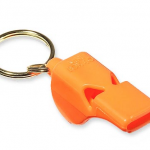 Whistle – Don’t leave home without it. A whistle’s sound carries much further than your yells for help. Three sharp blasts is the universal code for “Come Help Me Now!
Whistle – Don’t leave home without it. A whistle’s sound carries much further than your yells for help. Three sharp blasts is the universal code for “Come Help Me Now!
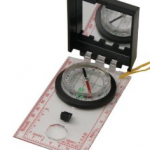 Mirror – The flash of a mirror is real attention getter. My compass has a mirror that can do double duty as a signaling device as well as telling me who to blame for my predicament.
Mirror – The flash of a mirror is real attention getter. My compass has a mirror that can do double duty as a signaling device as well as telling me who to blame for my predicament.
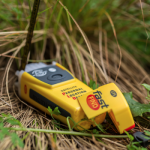 Satellite Communicators – A wide variety of electronic devices, with acronyms like ACR, SPOT, and PLB, exist that use an orbiting constellation of satellites to both determine our position and to rely that information to emergency response teams. These devices work in different ways so I’ll cover them in more detail at a later date.
Satellite Communicators – A wide variety of electronic devices, with acronyms like ACR, SPOT, and PLB, exist that use an orbiting constellation of satellites to both determine our position and to rely that information to emergency response teams. These devices work in different ways so I’ll cover them in more detail at a later date.
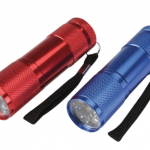 Flashlight – It’s only light about half the time and sometimes it’s hard to gauge the amount of time needed to finish a ride. When the sun goes down a good flashlight will do more than help you pick out the right trail, it’ll also help summon help when you pick the wrong route.
Flashlight – It’s only light about half the time and sometimes it’s hard to gauge the amount of time needed to finish a ride. When the sun goes down a good flashlight will do more than help you pick out the right trail, it’ll also help summon help when you pick the wrong route.
The wrong route. We’ve all been there. The key is knowing how to find your way after you realize your surroundings don’t look familiar. Staying Found is the topic that takes me to horse expos and equine clubs around the country, talking about how to use the map and compass that many riders have in their saddle bags. For those who say their animal will get them back. I wish you the very best and hope it works for you when you really need it. As for myself I’ll trust in a couple of time tested navigation devices to get me home.
 Map – Hopefully it’ll be for the area that you’re riding in. If not it’ll still help start a fire to keep you warm. Don’t know how to read a map? Learn. It’s not hard and any good boy scout can be coerced into helping.
Map – Hopefully it’ll be for the area that you’re riding in. If not it’ll still help start a fire to keep you warm. Don’t know how to read a map? Learn. It’s not hard and any good boy scout can be coerced into helping.
 Compass – Yes, moss grows on the north side of trees. It also grows on the east, west and south sides. You spent 5 or 10 dollars in gas just getting to the trailhead. You don’t need to spend much more to get a good compass. You should also invest a few minutes reading the directions that come with them. It’s amazing how many people carry a compass and don’t know what to do with them.
Compass – Yes, moss grows on the north side of trees. It also grows on the east, west and south sides. You spent 5 or 10 dollars in gas just getting to the trailhead. You don’t need to spend much more to get a good compass. You should also invest a few minutes reading the directions that come with them. It’s amazing how many people carry a compass and don’t know what to do with them.
Rides are always better with a snack along the way. For me that snack is usually an apple and a landjeager. In the context of an emergency though let’s toss in an extra something just in case. We all know that we’re not going to starve, even if we go without food for a few weeks. What that extra snack will do is help you keep warm and maybe help you think straight. Peanut M&M’s and Snickers bars line the bottom of my saddle bags.
Well, there you go. You may think that this is a big list suitable only for an expedition. I will respectfully disagree and suggest that YOUR life is worth carrying an extra pound or two to help ensure your safe return home. I think your friends and family would agree.
As always for more information on this topic as well as many others of interest to trail riders please visit www.TrailMeister.com the largest directory of mule trails and camping areas in North America.


